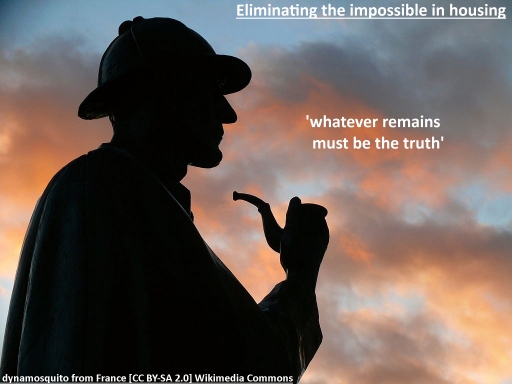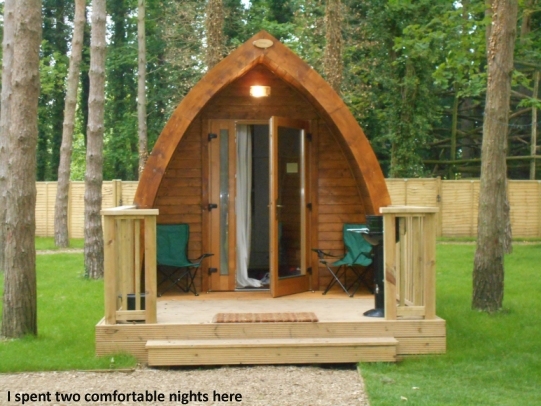An example of properly low carbon housing
Re-posted from dontlooknow.org (May 2018)
Cheap, neighbourly and doesn’t screw the world up
or
Wooden prefabs with market gardens
Written for a housing policy forum – part 16

We need housing that is cheap, neighbourly and doesn’t screw the world up. (Taking a suggestion from thesaurus.com the word ‘green’ will be used in place of “doesn’t screw the world up”.) Here is a summary of housing-related issues from earlier posts:
Issue 1. No high buildings.
Part 4 – We are not short of land, showed most of the UK is not over populated. Another post, Must a Green City have Tall Buildings, showed that Portsmouth was one of the densest cities in the UK but still had green open space and few high buildings.
Part 12 – Friends, neighbours and architectural determinism discussed the role of architecture on crime and neighbourliness. This is an area of conflicting research but it is likely that being housed in high buildings is detrimental to neighbourliness.
Part 13 – No more high buildings showed that high buildings have large carbon footprints. Also they are difficult to design well enough to provide cheap and reliable housing.
Part 15 – Five planning policies looked at some of the ideas that made high buildings popular with architects, planners and politicians.
Summary: Tall buildings cannot be cheap or green and are probably less neighbourly.
Issue 2. No cars in housing.
Part 7 – Pollution in towns, discussed local traffic pollution. This causes premature deaths. Globally, dust from tyre wear pollutes the oceans.
Part 11 – No cars in the city, showed mass car ownership cannot be green or cheap. A motorist cannot keep within any jusifiable remaining carbon budget. A study from the European Commision confirmed that cars cause a very large increase in the cost of living.
Summary: Cars in housing cannot be cheap or green.
Issue 3: Restrictive planning and greenbelts.
Part 4 – We are not short of land discussed the supply of building land. The most dense government region in the UK is London. Its density is at least nine times greater than any other UK region. In finding space to build houses, the restriction is not the amount of land on which houses can be built. It is the planning system that prevents building on large areas of the country.
Part 9 – Greenbelts discussed green belt policy, which confines new homes to land which is more difficult to develop (e.g. brownfield sites). Green belts contain industrialised farming, which is killing beneficial species and destroying soil productivity. Brownfield sites should become nature reserves and urban parks becoming the true ‘lungs of the city’.
Summary: Restrictive planning and greenbelts are not cheap or green.
Issue 4. Prefabrication and conventional housing.
Part 5 – Construction and prefabrication discussed new developments in prefabrication using cross-ply timber. These techniques can make homes that are cheap and low in carbon emissions. Traditional housing, using bricks, concrete and steel has very high emissions during construction – as discussed in Part 1- Embodied carbon and climate.
Summary: Prefabricated houses can be cheap and green. Convention building is expensive and construction methods are not green.
Issue 5: Food production and local employment.
Part 2 – Food and the remaining carbon budget showed the globalization of food supply is a large part of our carbon emissions due to transport and industrialised farming. Greenhouse gas emissions from livestock, particularly cows and sheep, are enormous and the effects are underestimated. Livestock husbandry can change good food into much less food. For example, when large amounts of corn are fed to cattle to produce much smaller quantities of beef.
Part 6 – Pollution in the countryside discussed other problems of modern industrialised farming, which destroys soil fertility, kills beneficial insects and may bring on the ‘nitrate time bomb’.
Part 9 – Greenbelts reported that other farming methods (organic, labour-intensive, polyculture) can exceed the food production of industrialised farming. They use much less land and produce varied crops making them suitable for local delivery- cutting food miles. They also create local employment.
Summary: Local labour-intensive food production can be much greener than industrialised farming. It can protect soil health and beneficial insects. It creates local employment and reduces food miles.
What remains?
For cheap and green housing, these must be eliminated or minimised:
High buildings
Cars
Greenbelts and restrictive planning
Conventional construction
Industrialised farming
Having eliminated these expensive and unsustainable alternatives, we must look at what remains?One possibility is …
Estates of car-free, wooden prefabs with integrated market gardens

This shed that I stayed in is a bit small for conventional living: It needs an en-suite loo – rather than a nearby toilet block – and a bit more of a kitchen. However, put it near a bike track to a decent nearby town, it would suit a single old man like me.
Larger units for families can be found on many park home sites across the country. With sufficient demand and managed competition these could be very cheap. York Plotlands Association argues that starter homes should cost as little as £20,000 – about one tenth of the cost of conventional housing.
Is this aim realistic? In Who needs a mortgage? Couple’s ultimate downsize from a 2,500 sq ft home to a shotgun shack, the Daily Mail’s Rachel Quigley told of a couple in the USA that downsized from a large, four-bedroom house on an acre-and-a-half of land:
Now they live, work and school their child in a shotgun 320-square-foot shack they custom built. They pay no mortgage, they have few belongings, they spend more time with their son and they are happy.
Their house cost them less than $20,000 [i.e. less than £15,000] to make their home and they only pay $145 rent for the lot on which their shack and workshop stands.
A new Ministry of Works … & starter homes for £20,000
What is needed is an approach similar to the programme of the Ministry of Works for temporary housing at the end of World War 2:
When the Ministry of Works opened up the design competition, some 1,400 designs were submitted. Reviewed by the Building Research Station, many were rejected from the conceptual stage… However, a few were approved after testing for construction.
The present housing crisis needs a similar approach with a new Ministry of Works, empowered to make specifications and to commission prototypes.
The crisis also needs action on the cost of land.
In the York area, a plot of land big enough for a house costs less than £1000 but when it becomes building land it can cost £100,000 or more. That’s a windfall to landowners, called ‘planning gain’ . This is built into the price of a new house.
Is this estimate of £100,000 too high? Probably not – figures from the government in 2015 gave the average price for a hectare of agricultural land as £21,000 and, in York, the price of a hectare of building land as £2,469,000. That’s an increase in value of over 100 times. This increase happens when planning permission is granted – before any building work starts. In Enfield, North London, the increase is over 700 times.
The aim of the new Ministry should be to remove planning gain from the cost of housing so a plot costs £1,000 or so. It should commission modern prefabricated design for starter homes with a target price of less than £20,000.
Neighbourliness and prefab estates
Car-free estates of modern wooden prefabs can be cheap and green. Can they be neighbourly? Were the prefab estates of the past neighbourly?

Here, academic research is, at best, sparse but there are several press reports. For example, Robert Hardiman’s article in the Daily Mail, Absolutely prefabulous: Residents of Britain’s last prefab estate battle to save homes that were built to last only ten years reports the reactions of residents on the Excalibur Estate in Catford before it was demolished:
‘Round here, people still look after each other. Say “hello” to a stranger anywhere else and they think you’re a nutter. But not here. We’re old school,’ says retired building manager, Jim Blackender.
‘There’s a waiting list to live here. On the other estates, there’s a waiting list, too — to get out.’
In the Yorkshire Evening Post, there is Leeds Nostalgia: Prefabs were fab, say ‘Cottingleyites’:
The close-knit community of the Cottingley residents is perhaps the most treasured memory of life on the estate and this family-like spirit has remained something that most have struggled to recapture, as Jeff Carter recalls.
‘When I was growing up, there were lots of other kids growing up together. Most of the families were ex-service people and, as it was shortly after the end of the war, there was a great camaraderie among the residents. There was a great community spirit that is difficult to put into words and it is something which, I feel, could never be recreated today.’
As PrefabsAreForPeople noted in 2004:
Leeds City Council wants to demolish other prefabs that residents desperately want to keep, some having lived there since they were built. In the Yorkshire Evening Post on 27th September 2003, Nick Ahad reports the council as saying:
The council insists it is required to bring the homes to the Government’s new Decent Homes standard by 2010.
Bizarrely the Decent Homes Standard is part of the ODPM’s “Creating Sustainable Communities” initiative. In this case, of course, destroying sustainable communities.
The council say:
“We understand the concerns of the community. Everyone will be entitled to compensation.”
But how much will the compensation be for the loss of good friends and neighbours and a “Sustainable Community”.
Robert Hardiman’s Daily Mail article criticised council planning policy:
But Excalibur [prefab estate] is also a headache for the local council, a nose-thumbing contradiction of every rule in the modern Town Hall handbook.
He reports a resident’s scathing comment:
‘once the council decided they were going to rebuild, they stopped spending any more money on the place so it’s gone downhill. Now we’ve got damp and these houses just aren’t fit for the 21st century any more. We can’t afford to renovate this place ourselves, so we want a new home.’
He ends:
Yet, our history is here in these ingenious 20th century bungalows. They did not just provide homes fit for heroes. They have also put the high-rise arrogance of Britain’s modernists to shame.
Conclusion: Prefab estates have the potential for being friendly and neighbourly. Here is the summary from PrefabsAreForPeople:
- People liked prefabs
- Multistorey mass housing failed
- The planners didn’t notice
- They will get it wrong again
The changing economy
To save the world from climate disaster and allow a decent lifestyles, our lifestyles need to change. We must stop most air flights and minimise car use. We must minimise beef consumption and building with bricks and steel. In the short to medium term this will mean de-growth – a shrinking economy at a time when robots are taking over existing jobs.
A new Ministry of Works should be created to find new ways of living that are cheap, green and neighbourly. A start would be car-free estates of wooden prefabs with integrated market gardens. The new ministry should investigate the place of housing in the economy – local, national and global.

Perfectly understandable; well argued;a narrative that deserves a widening conversation among representatives from National to Local Organisations.